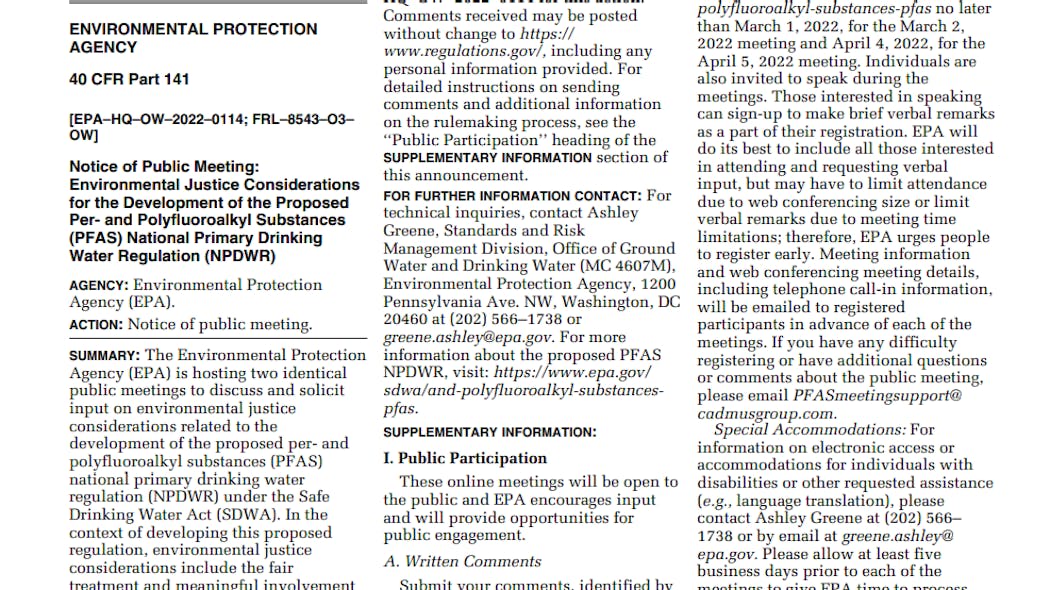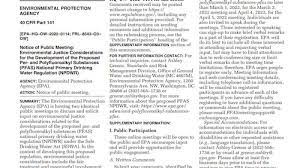March 15, 2023 The EPA’s goal is to limit PFAS, the so-called forever chemicals, to less than four parts per trillion in drinking water.
By Matthew Medsger Source Boston Herald Distributed by Tribune Content Agency, LLC.

Faced with congressional inaction on the matter, the president has instructed the EPA to issue limits on the amount of so-called forever chemicals which can be measured in the nation’s drinking water.
“Today the Environmental Protection Agency (EPA) proposed the first-ever national standard to address PFAS contamination in drinking water. EPA will require public water systems to monitor for six PFAS chemicals, notify the public if the levels of these PFAS exceed the proposed regulatory standards, and take action to reduce the level of PFAS in the water supply,” the White House announced Tuesday.
The Biden-Harris Administration, through the EPA, is proposing a drinking water limit for two common PFAS chemicals, otherwise known as per- and polyfluorinated substances, according to the White House.
According to the proposed rules, levels of PFOA and PFOS — perfluorooctanoic acid and perfluorooctane sulfonic acid — in water will need to measure under four parts per trillion.
“EPA’s proposal to establish a national standard for PFAS in drinking water is informed by the best available science, and would help provide states with the guidance they need to make decisions that best protect their communities. This action has the potential to prevent tens of thousands of PFAS-related illnesses and marks a major step toward safeguarding all our communities from these dangerous contaminants,” EPA Administrator Michael Regan said along with the announcement.
The class of chemicals, first developed by 3M in the late 40s, were used commonly in a number of household and industrial products until very recently; non-stick cookware, popcorn bags, fast food wrappers, firefighting foam and semiconductors were all manufactured using PFAS chemicals.
It wasn’t until decades later that consumers began to learn that so-called forever chemicals had a negative impact on human health.
According to a court-ordered study conducted following a class-action lawsuit settlement over PFAS contamination around the Ohio Valley, there is a link between PFAS exposure and diagnosed high cholesterol, ulcerative colitis, thyroid disease, testicular and kidney cancer and pregnancy-induced hypertension.
Up until 2016 the EPA did not have an established safe limit for PFAS presence in drinking water, though their Office of Water had issued a recommendation to avoid short-term exposure — that’s 24 hours of exposure in 30 days — to water containing more than 400 parts per trillion.
In the summer of 2016, after elevated levels of PFOA were found in the water surrounding Saint-Gobain Performance Plastics plant in Merrimack, New Hampshire and elsewhere in the U.S., the EPA revised their guidelines and recommended a less than 70 parts per trillion limit for tested ground water.
Earlier in the month, the Massachusetts Department of Public Health warned residents against eating fish caught in several state parks due to elevated levels of PFAS in the animals’ bloodstreams.
The Biden Administration’s proposal will not become enforceable until after a public comment period and may change before enactment. EPA is requesting comment from the public, water system managers, and public health professionals on docket ID No. EPA-HQ-OW-2022-0114, at www.regulations.gov.
